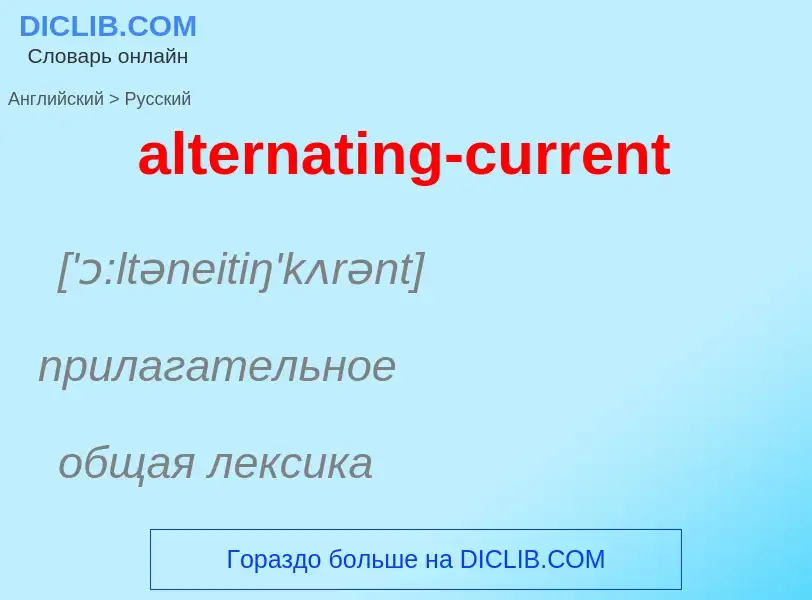Перевод и анализ слов искусственным интеллектом ChatGPT
На этой странице Вы можете получить подробный анализ слова или словосочетания, произведенный с помощью лучшей на сегодняшний день технологии искусственного интеллекта:
- как употребляется слово
- частота употребления
- используется оно чаще в устной или письменной речи
- варианты перевода слова
- примеры употребления (несколько фраз с переводом)
- этимология
alternating current - перевод на русский
['ɔ:ltəneitiŋ'kʌrənt]
прилагательное
общая лексика
переменного тока
[ɔ:ltəneitiŋ'kʌrənt]
общая лексика
AC, a.c.
переменный ток
электрический ток, меняющий своё направление с частотой 50 Гц - в России и 60 Гц - в США. Может быть представлен в виде синусоидальной волны
антоним
Смотрите также
общая лексика
колебательный ток
общая лексика
пульсирующий ток (не проходящий через нулевые значения)
общая лексика
пульсирующий ток (не проходящий через нуль)
общая лексика
поток воды
течение воды
Определение
Википедия
Alternating current (AC) is an electric current which periodically reverses direction and changes its magnitude continuously with time in contrast to direct current (DC), which flows only in one direction. Alternating current is the form in which electric power is delivered to businesses and residences, and it is the form of electrical energy that consumers typically use when they plug kitchen appliances, televisions, fans and electric lamps into a wall socket. A common source of DC power is a battery cell in a flashlight. The abbreviations AC and DC are often used to mean simply alternating and direct, respectively, as when they modify current or voltage.
The usual waveform of alternating current in most electric power circuits is a sine wave, whose positive half-period corresponds with positive direction of the current and vice versa. In certain applications, like guitar amplifiers, different waveforms are used, such as triangular waves or square waves. Audio and radio signals carried on electrical wires are also examples of alternating current. These types of alternating current carry information such as sound (audio) or images (video) sometimes carried by modulation of an AC carrier signal. These currents typically alternate at higher frequencies than those used in power transmission.

![The prototype of the ZBD transformer on display at the Széchenyi István Memorial Exhibition, [[Nagycenk]] in [[Hungary]] The prototype of the ZBD transformer on display at the Széchenyi István Memorial Exhibition, [[Nagycenk]] in [[Hungary]]](https://commons.wikimedia.org/wiki/Special:FilePath/DBZ trafo.jpg?width=200)

![Three-phase high-voltage [[transmission line]]s use alternating currents to distribute power over long distances between [[electric generation]] plants and consumers. The lines in the picture are located in eastern [[Utah]]. Three-phase high-voltage [[transmission line]]s use alternating currents to distribute power over long distances between [[electric generation]] plants and consumers. The lines in the picture are located in eastern [[Utah]].](https://commons.wikimedia.org/wiki/Special:FilePath/Highvoltagetransmissionlines.jpg?width=200)
![Westinghouse Early AC System 1887<br /> ([https://web.archive.org/web/20090325121254/http://www.pat2pdf.org/patents/pat373035.pdf US patent 373035]) Westinghouse Early AC System 1887<br /> ([https://web.archive.org/web/20090325121254/http://www.pat2pdf.org/patents/pat373035.pdf US patent 373035])](https://commons.wikimedia.org/wiki/Special:FilePath/WestinghouseEarlyACSystem1887-USP373035.png?width=200)
![The Hungarian "ZBD" Team ([[Károly Zipernowsky]], [[Ottó Bláthy]], [[Miksa Déri]]), inventors of the first high efficiency, closed-core shunt connection [[transformer]] The Hungarian "ZBD" Team ([[Károly Zipernowsky]], [[Ottó Bláthy]], [[Miksa Déri]]), inventors of the first high efficiency, closed-core shunt connection [[transformer]]](https://commons.wikimedia.org/wiki/Special:FilePath/ZBD team.jpg?width=200)
